The Horsemen of the Southern Plains
Thank you for reading this post, don't forget to subscribe!The Comanches emerged as a distinct tribe during the latter 1600’s. They are thought to have broken off from the Shoshone’s. Of all the Plains warriors none were as skilled horsemen as the Comanches. The Comanches are thought to have received their first horses from the Pueblo Indians after the Pueblo Revolt of 1680.
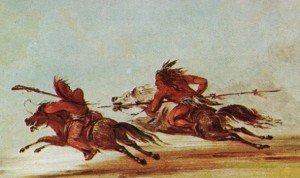
Comanche horsemanship started at a young age. From the time a Comanche child was perhaps four or five years old they owned a pony. Boys were known to drill every day with their horse. This daily drilling sharpened their equestrian skills to a very high degree. One type of practice a typical Comanche boy would work at was to ride his horse at a gradually higher speed while picking up objects off of the ground. At first, the objects might be small and light weight but gradually they would be larger and heavier. The boy would continue to drill with his horse and eventually be able to pick up a body from the ground while riding. This was considered an excellent trait to possess in the heat of battle. It was a skill excelled by the Comanche.
A Comanche’s horse was known to have great agility, speed and endurance. Likewise, the Comanche horse was noted for it’s alertness. These horses were known to respond instantly to word or touch. Some would say they could even anticipate their rider’s command.
How was it that the Comanches possessed such trainable animals? The answer was in their breeding. The Comanche was known to breed only the most fast and responsive stallions as studs.
The Horse Changed the Culture of Plains Indians
Since it were the Spaniards who introduced the horse in today’s western United States, there was a time when plains Indians lived without the benefit of these animals. Horses were brought into the southwest and the Plains grasslands with the Coronado Expedition of 1540. Prior to the horse, tribes lived a semi-sedentary life working the fertile soil along river bottoms. The buffalo, always an important animal to the Plains Indians, was hunted during the summer and fall.
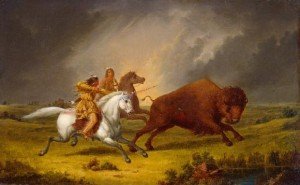
It was the Indians of the Southwest, who were the first to come in contact with Coronado, who were the first introduced to the horse. At first, the Indians were only known to tend the horses for the Spaniards. As time progressed they owned their own herds. Toward the end of the 1700’s, most grassland tribes also owned horse herds.
When we see paintings today of Indian buffalo hunts we see the Native on horseback chasing and overtaking the herd. Before the horse, as mentioned above, the important hunts certainly took place but without the aid of a fast horse. When the horse was introduced to the Plains tribes, everything changed. The old village life suddenly seemed tame. Now the Natives could ride fast and dart and weave through the buffalo herds. Tribes that did not necessarily take to the horse immediately with the same enthusiasm nevertheless appreciated the freedom of being able to ride. As some would say, ride with the wind.
Plains Indians took to horses with such a skilled degree that it’s almost impossible to think of them without their mounts. Indian horses evolved from the half-Arab, half-Andalusian stock brought over by the Spaniards. By about 1800, this original stock evolved into the typical Indian pony with it’s relatively small size and shaggy coat. What’s interesting is that the Europeans who came west with their larger grain fed mounts didn’t have much respect for the smaller Indian ponies. As it turned out however, during buffalo hunts or in battle, the Indian mounts performed better than those of the Europeans.
Try our fun twenty-five question history quiz
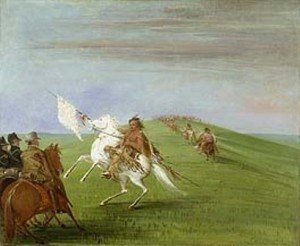
Horse Warriors
The introduction of the horse also dramatically changed inter tribal warfare. Native Americans, like many groups, have always battled among themselves from time to time. The horse added a new dimension. A warrior was always known to keep his horse tied up near his tepee. The horse’s owner was it’s only rider. When preparing for battle a warrior would paint up his horse as well as himself. Multi-colored designs were the norm. In addition, a warrior would add adornments to his horse. This might include feathers, scalp locks and ribbons received from traders.
In the heat of battle, a Plains warrior might often drop down on one side of his horse. One leg would be over the horses back and an elbow in a sling on the horses neck. It was from this position that the warrior would operate his bow and arrow. Using the horse as a shield the warrior would shoot his arrows either from over the horses back or from under the horses neck.
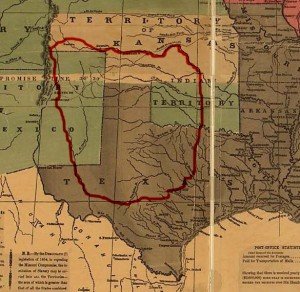
Comanche Warriors
Many historians contend that the Comanches were the fiercest of all Indian warriors. Even more so than the Apaches. Their horsemanship skills no doubt added to this reputation.
Warfare was a big part of Comanche life. They developed methods for using traditional weapons while fighting on horseback. Their skill was apparent in Texas as well as across the border into Mexico. For decades, Comanches fought a rather running battle with Texas pioneers who were gradually moving westward from east Texas. The Comanches roamed the area called “Comancheria” as shown on the above map image. This was before and after Texas became a republic as well as during the Spanish occupation of the region. One of the main tasks assigned to the famed Texas Rangers was to protect settlers from Comanche raids. In addition to raiding white settlers, the Comanche was at various times, at war with just about every other Native American group residing in the Great Plains.
Noted battles involving Comanches against white settlers and buffalo hunters included the two Battles of Adobe Walls in the Texas Panhandle, the Battle at Plumb Creek in Texas, the Battle at Crooked Creek in Kansas. The final Comanche battle took place in 1875 at Palo Duro Canyon just southeast of today’s Panhandle city of Amarillo Texas. This was the conflict that ended in the surrender of the famed Comanche warrior and half breed, Quanah Parker.
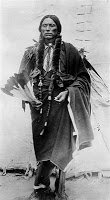
Comanche historians know that Quanah Parker’s mother was Cynthia Ann Parker, the young hostage taken during a bloody Indian raid on Fort Parker during the 1830’s in today’s east central Texas. Two interesting things about Quanah Parker was that he was arguably the most effective Comanche warrior in his tribe’s history, and somewhat surprisingly, after his surrender and move to the Indian Territory became a solid friend of the white man and adopted many of the white mans ways.
Parker went on to befriend many a Texas rancher as well. In 1905, Quanah Parker rode in President Theodore Roosevelt’s Inaugural Parade in Washington D.C. In addition, Texas has a town named after the Comanche warrior, Quanah Texas, on US Hwy 287 just northwest of Wichita Falls. Before his death in 1911 Parker had become a type of elder statesman for his people. Two thousand people attended his funeral.
Two additional articles on our Western Trips site you’ll want to see are A Visit to Quanah Texas and the Story of Colonel Ranald Mackenzie and Fort Concho Texas.
Sites to Visit
The Quanah Parker Star House– The Quanah Parker Star House was built around 1890 for the famous Comanche warrior. Quanah had 14 stars painted on the roof of his house, a smoke house and a summer house. Funding for the construction was provided by a Texas rancher and friend of Parkers, Samuel Burk Burnette. In 1956 the house was relocated to Eagle Park fortunately saving it from destruction. Originally located near the Wichita Mountains, the house now resides in Cache Oklahoma. Much of the park today is a ghost town, the Star House however is still host to Comanche events.
Quanah , Acme and Pacific Railroad Museum– Located in Quanah Texas northwest of Wichita Falls, this museum is a treasure trove of regional information. This museum is in the former railroad depot for a Texas town that once was a key stop on the railroads, but no longer.
Comanche National Museum and Cultural Center– This museum located in Lawton Oklahoma offers visitors a glimpse of traditional cultural items and detailed history about the Comanche tribe. Its purpose is to allow visitors a better understanding about the Comanche People. The museum opened in 2007 by a group of tribal members.
(Photos and images from the public domain)
